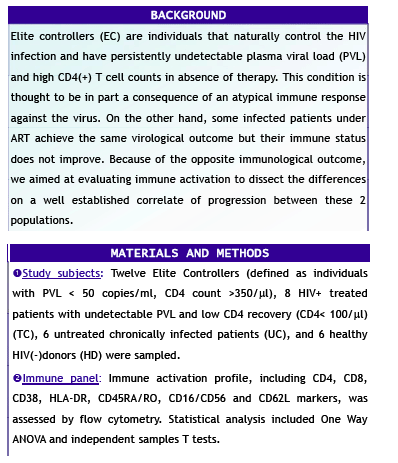 |
 |
 |
| |
HAART Did Not Control Immune Activation
|
| |
| |
IAS Capetown July 2009
Reported by Jules Levin
AUTHOR CONCLUSIONS:
In spite of showing viral suppression similar to elite controllers , HARRT treated with undetectable viral load patients (TC) not only don't recover their CD4 counts but show an activated phenotype in this cellular population similar to untreated patients. This would indicate that even in the absence (or minimal) of PVL considerable viral replication must be occurring in reservoirs in TC patients inducing a stronger immune activation making difficult the regeneratn in quantity and quality of their T-cells, influencing in turn their clinical outcome.
Immune activation profile comparison between elite controllers and treated HIV-1(+) patients with undectable plasma viral load and low CD4 count recovery
N. Laufer1,2, M. Carobene1, G. Turk1, O. Sued2,3, Y. Ghiglione1, A. Krolewiecki3, C. Cesar2,3, M. Saracco1, P. Cahn2,3, H. Salomón1
1National Reference Center for AIDS, Microbiology, School of Medicine, University of Buenos Aires, Ciudad Autonoma de Buenos Aires, Argentina, 2Hospital J. A. Fernández, Ciudad Autonoma de Buenos Aires, Argentina, 3Área de Investigaciones Clínicas de la Fundación Huesped, Ciudad de Buenos Aires, Argentina
Background: Elite controllers (EC) are individuals that naturally control HIV infection in the absence of ART. On the other hand, some infected patients under ART achieve the same virological outcome but their immune status does not improve. Because of the opposite immunological outcome, we aimed at evaluating immune activation to dissect the differences on a well established correlate of progression between these 2 populations.
Methods: Twelve EC (defined as < 50 copies/ml, CD4>350/ml), 8 HIV+ treated with undetectable PVL and low CD4 recovery (CD4< 100/ml) patients (TC), 6 untreated chronically infected patients (UC), and 6 healthy HIV(-)donors (HD) were sampled. Immune activation profile, including CD4, CD8, CD38, HLA-DR, CD45RA/RO, CD16/CD56 and CD62L markers, was assessed using FACS. Statistical analysis included One Way ANOVA and independent samples T tests.
Results: We found that EC showed statistically significant differences (p< 0.05) in their immune activation profile when compared to the TC group. Major differences were found in the median percentage of CD4(+)/HLADR (15.6% vs 45.6%), CD4(+)/CD38(+) (32% vs 51%), CD4(+)/HLADR/CD38(+) (4.4% vs 13.3%), CD8(+)/CD45RO (49% vs 73.3%) and CD8(+)/CD45RA/CD62L (29.8% vs 15.6%) T cells. Also, CD4(+)/CD38(+) and CD4(+)/HLADR/CD38(+) mean percentages were different between EC and UC. In addition, CD4/CD8 ratio means were different between EC and TC (1.1 vs 0.15).
Conclusions: In spite of showing viral suppression similar to EC, TC patients not only don´t recover their CD4 counts but showed an activated phenotype in this cellular population similar to untreated patients indicating that even in the absence of detectable PVL, considerable viral replication must be occurring in reservoirs inducing a stronger immune activation making difficult the regeneration in quantity and quality of their T cells.


|
| |
|
 |
 |
|
|